| Previous Day | Return to Lincoln Diary | Next Day |
Day 6 - Dixon IL to Marshalltown IA
 |
From the Diary of Eagle Scout Bernard R.
Queneau Member of the 1928 Lincoln Highway BSA Lincoln Highway Promotional Tour Thursday - July 19, 1928 - We had a very cheap breakfast this morning, but the town is very small. At Cedar Rapids, where we stayed at noon, we gave a demonstration. We practiced about an hour here for the life-saving demonstration for the one to be given in Ames. Mr. Lombardi got rather peeved at our tryout. Here we drove out to the Indian Reservation with Mr. (?), the District Executive. We visited the cemetery where they are buried right on the top. At night we stopped at Marshalltown where we used the cooking kit for the first time and gave a demonstration at dusk. |
| Friday - August 22nd We go from Dixon IL to Marshalltown IA today. As we pack up Sophie, the weather is a good 40 degrees cooler than yesterday – a welcome cold front has moved in without bringing rain or storms. It is clear and sunny - perfect traveling weather! We exit through Dixon’s arch and head west. The Tour crosses the great Mississippi this morning as we head into Clinton, IA for our first stop |
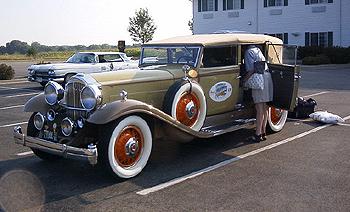 |
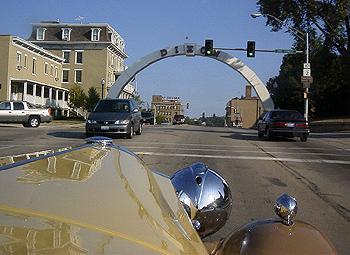 |
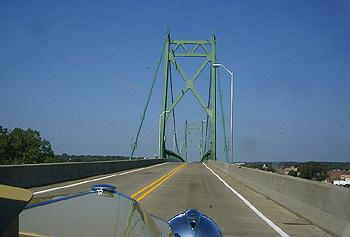 |
|
Just over the Mississippi River Bridge we turn off Route 30 and make our way back to the riverfront and the Clinton Historical Society. The town may be small, but it has a big appreciation for the past. The Historical Center is located in an old schoolhouse building next to the levee. For the first time on the trip, the Boy Scouts of America are actively participating – providing parking assistance as we pull in. I have been surprised that there is not more Scout activity on the tour, since we are actually celebrating the 75th anniversary of the Boy Scouts erecting markers on September 1st, 1928 |
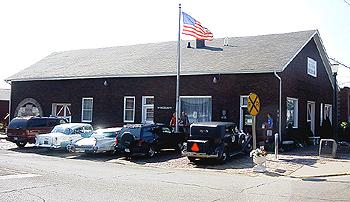 |
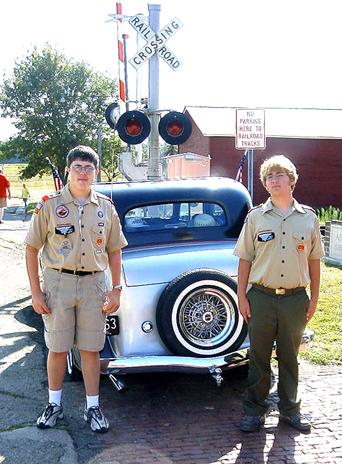 |
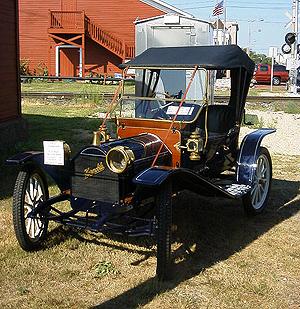 |
|
There is a beautiful 1907 Hupmobile outside the library, as well as other old cars belonging to local auto enthusiasts. We pull in around back, right up against the embankment of the levee. It is hard to believe that the river could rise high enough to flood over – the water is a good 20 feet below. Just outside the entrance of the Historical Society building is a monument to old buildings that have been torn down over the years – cornerstones and concrete name plates dating from 1854 adorn the display. Inside is a remarkable display of items from Clinton’s past, including a man-powered fire engine from the mid-1880s. There are displays of typical household scenes, maps, photos, newspapers, and just about anything else you can imagine to trace the history of the small town. They have also set out juice, coffee, and pastries – more food. |
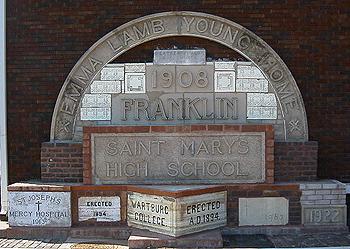 |
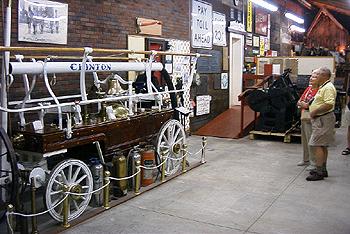 |
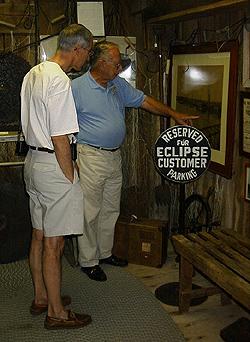 |
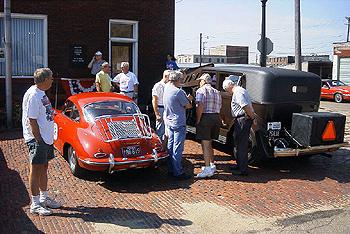 |
|
Meanwhile, the tour participant’s cars are gathering an audience of their own – at the front door we have accidentally paired up the two most contrasting cars – the Chaisson 1964 Porsche 356C and the Woolfitt 1934 Packard V-12. A lot of local car enthusiasts have brought their collector vehicles out as well, creating an impromptu car show. And nobody can complain that we don’t have color – between the bright yellow Carr Hummer and the Tillett’s lavender 1958 Oldsmobile, we will definitely be seen. After browsing the historical center, a lot of the participants (like Charlie and Audrey Bronk) took a walk along the top of the levee to look at the river. Then it was off again, this time to roll down a long section of the original Lincoln Highway that is pretty much the way it was when it was built in 1928. |
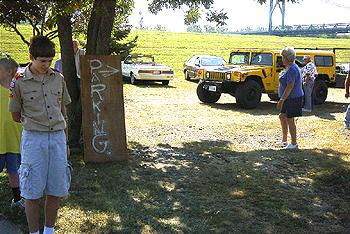 |
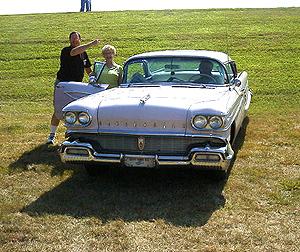 |
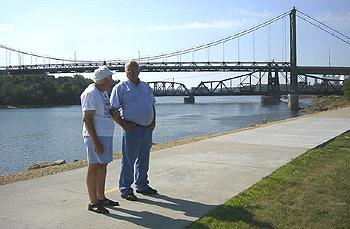 |
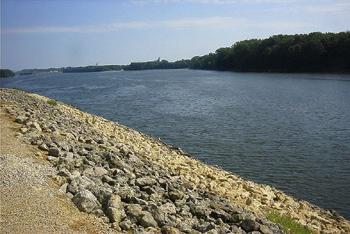 |
|
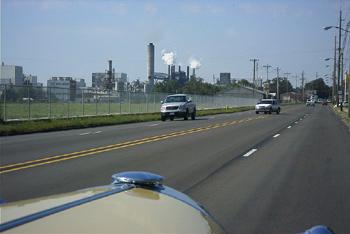 |
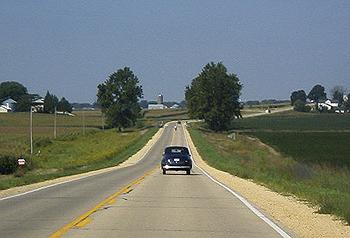 |
|
|
Talking about contrast, we go along new Route 30 and the industrial section first. Billowing smoke and flames shoot into the sky from some sort of refinery. The odors of machinery and chemicals seem harsh after miles of sweet clover, corn, and the occasional reminder that this is also cow and pig country. (OK, the machinery and chemicals aren’t the WORST thing we smell). The entrance to the old road is actually blocked off, so we have to go down a bit to a gravel access road and cut over. Once we turn onto the narrow highway, it is like going back in time. No traffic, no road signs – just one-lane bridges and lots of trees. The old section of road ends all too soon, and we are back on 30W heading to Mount Vernon for lunch. |
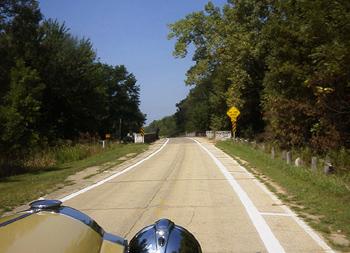 |
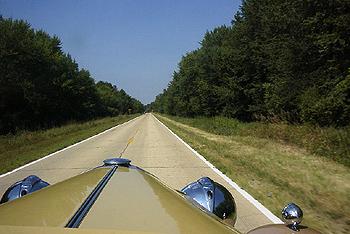 |
|
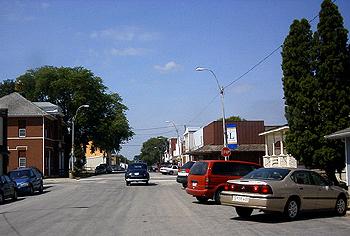 |
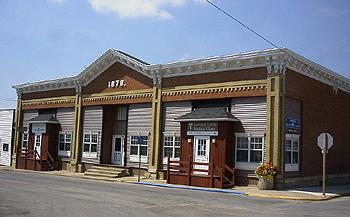 |
|
We get waylaid before we get there in the tiny community of Clarence, IA. As we drive through, a camera crew (armed with a mike and a Sony Videocam) asked us to please stop for an interview on the local cable channel. Assuming that he had picked us out because of our obviously superior good looks and intelligence (not to mention having the neatest set of wheels), we pulled over for our fifteen seconds of fame. Only to find that he was asking EVERYONE to stop and be interviewed. Clarence was extremely excited about being on the Lincoln Highway route, and had even made up T-shirts to commemorate the event (at only $5 each!). As I was inside the shop buying shirts, I saw Bob and Shirley Woolfitt on TV, where Bob shamelessly plugged the TRAACA participation and this web site. The interviews were being broadcast live, a fact that escaped a couple of the Tour participants who joked around a little before finding out that it was too late to edit. Anyone who happened to be watching ended up with way more than they ever wanted to know about the Lincoln Highway, but we all had a lot of fun. The town was very small, perhaps a couple of hundred residents next to a train track that carries about 100 trains a day. It almost looks like a slice of life from the 1950s – except that the T-shirt shop had its catalog on CD-ROM and has its own web site. |
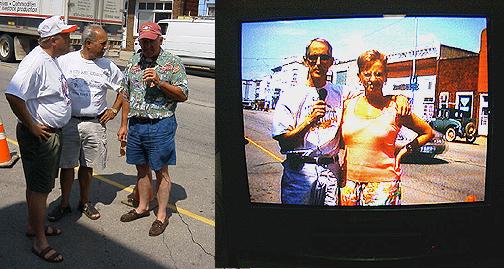 |
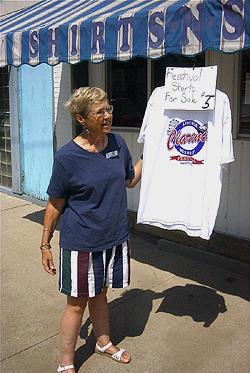 |
| When we finally tore ourselves from the spotlight in Clarence, we continued on to Mount Vernon IA for lunch. The business district actually has a stoplight (the only one in town), and had blocked off part of the main street for the tour cars to park. We all eat at the Lincoln Café, a really nice place with what Shirley Woolfitt identifies as ‘upscale ambiance’ with low prices and good food. They also advertised Carolina Bar-B-Que, something that raised eyebrows on both the Tilletts (from Kitty Hawk) and John Peters (Bar-B-Que expert). Questioning the waitress, we find out that the cook is from North Carolina, and they even provide a free sample that passes both Tillett and Peters taste tests with flying colors. Then we headed off to explore some of the small antique shops, ever mindful that Sophie is already rather well stuffed. |
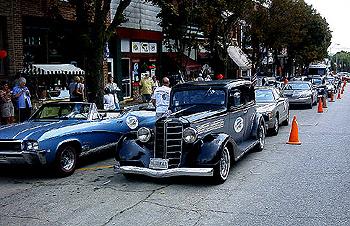 |
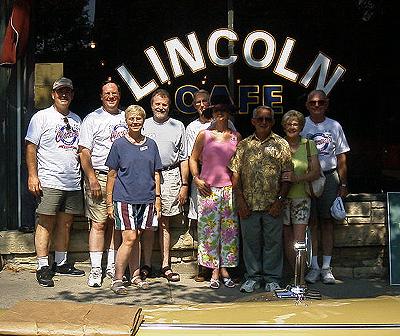 |
|
Now I have to admit a major oversight on my part. If you have been following this diary, you might have noted a barely mentioned presentation by the Boy Scouts. What I find out today is that the presentation was being made to a very special member of the Lincoln Highway Tour that I did not know anything about. Back in 1928, the Lincoln Highway Association enlisted the aid of the Boy Scouts of America to remark the entire highway on September 1st by erecting the concrete posts that have been shown on several of these diary pages. Four Eagle scouts were selected to travel the route from New York to San Francisco to promote the event, traveling in a REO Speedwagon designed to look like a Conestoga wagon. The scouts put on demonstrations in towns all along the route, and were honored by State and Local officials. Fifteen year-old Bernard R. Queneau was one of those Eagle scouts, and 75 years later he has returned with his new bride Esther to relive that journey. He has given up the Conestoga wagon for a Buick sedan (which he is driving across country himself), but at 91 he is still full of enthusiasm and energy. And still being honored by State and Local officials. In Mount Vernon, he is given the key to the city by the Mayor. Bernie has a scrapbook with photos of his tour, one of which shows the entire Boy Scout group from 1928. He points to the picture with a grin. “Even then I was awful short. See? The shrimp of the bunch.” |
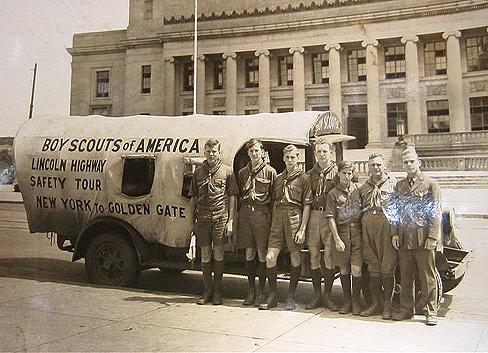 |
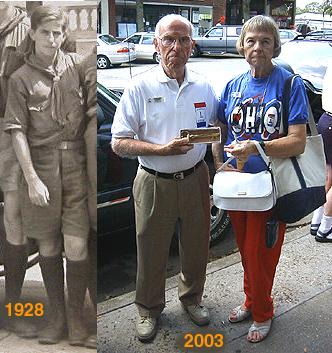 |
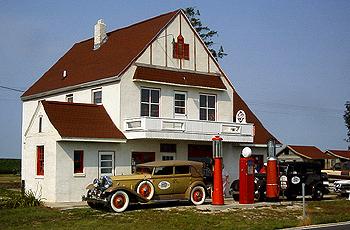 |
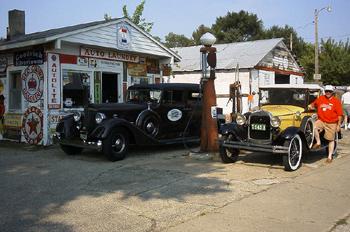 |
|
We leave Mount Vernon and continue on to an unscheduled photo opportunity at a period gas station right on Route 30, and then a stop at Preston’s Gas Station in Belle Plain IA. This old gas station dates back to the 1920s, and has a wonderful collection of old signs, machinery, and oddities such as a stuffed two-headed calf. There are two Model T Fords buried under clutter in the back, and an assortment of farm equipment is scattered over the property. Once again there are refreshments provided by the local community, along with the chance to see some of their interesting autos. A really sharp 1924 Model T Ford was parked here, and it ran as good as it looked. |
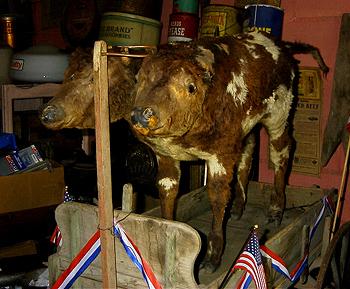 |
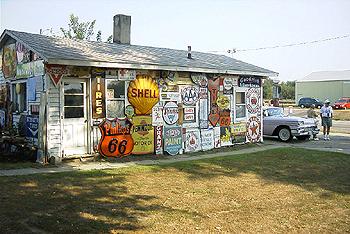 |
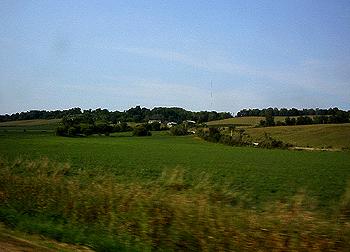 |
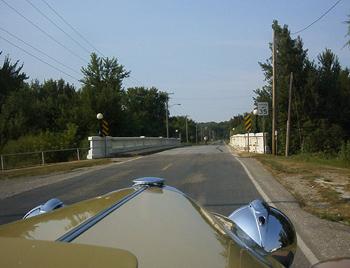 |
|
We took the old Route 30 into Marshalltown and the Hotel. The rolling hills are a change from the flat cornfields of previous days. A nice dinner has been made available at Stone’s Restaurant, but Bill meets with friends he hasn’t seen in a couple of decades, and Ken and I decide to pick up something at one of the fast food places close to the hotel. Ken has called in a prescription to be filled at the Wal-Mart across the street, and I want to catch up on the diary. Today has been the best of the tour so far - it is almost like a light switch has been thrown to turn on the small-town charm and enthusiasm that I had hoped to experience. Between the more obvious events such as the TV interviews and blocked streets, we have seen people sitting on the edge of the road in lawn chairs, waving banners and signs as we drive by. With no real schedule, these folks wait patiently for us to make an appearance. Some have set up little stands with refreshments, or parked old cars out front with signs inviting us to stop and visit. We are hoping that we'll see more of this community spirit as we continue west. |